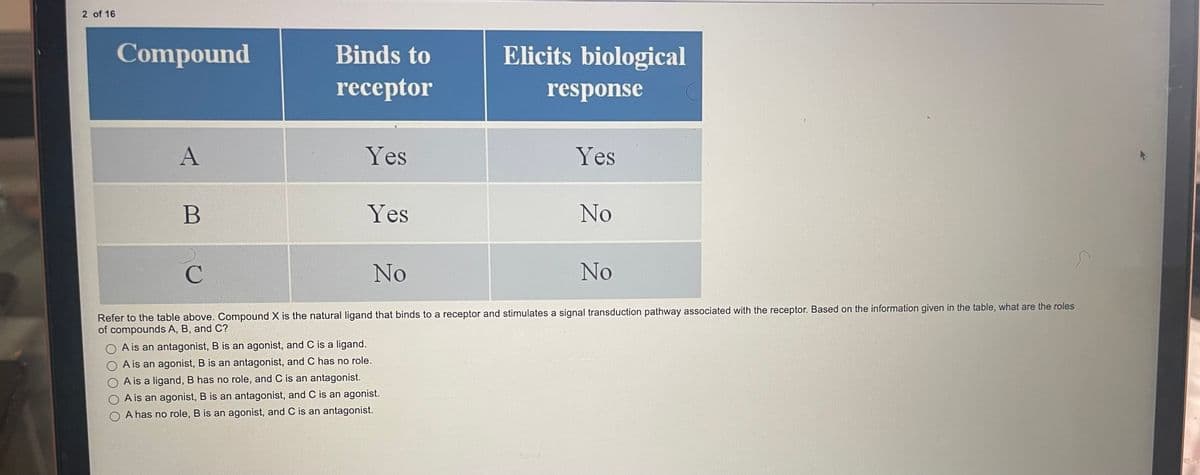2 of 16 Compound Binds to Elicits biological receptor response Yes Yes Yes No No No Refer to the table above. Compound X is the natural ligand that binds to a receptor and stimulates a signal transduction pathway associated with the receptor. Based on the information given in the table, what are the roles of compounds A, B, and C? O A is an antagonist, B is an agonist, and C is a ligand. O A is an agonist, B is an antagonist, and C has no role. O A is a ligand, B has no role, and C is an antagonist. O A is an agonist, B is an antagonist, and C is an agonist. O A has no role, B is an agonist, and C is an antagonist.
2 of 16 Compound Binds to Elicits biological receptor response Yes Yes Yes No No No Refer to the table above. Compound X is the natural ligand that binds to a receptor and stimulates a signal transduction pathway associated with the receptor. Based on the information given in the table, what are the roles of compounds A, B, and C? O A is an antagonist, B is an agonist, and C is a ligand. O A is an agonist, B is an antagonist, and C has no role. O A is a ligand, B has no role, and C is an antagonist. O A is an agonist, B is an antagonist, and C is an agonist. O A has no role, B is an agonist, and C is an antagonist.
Biology: The Dynamic Science (MindTap Course List)
4th Edition
ISBN:9781305389892
Author:Peter J. Russell, Paul E. Hertz, Beverly McMillan
Publisher:Peter J. Russell, Paul E. Hertz, Beverly McMillan
Chapter9: Cell Communication
Section: Chapter Questions
Problem 5TYK
Related questions
Question

Transcribed Image Text:2 of 16
Compound
Binds to
Elicits biological
receptor
response
A
Yes
Yes
B
Yes
No
C
No
No
Refer to the table above. Compound X is the natural ligand that binds to a receptor and stimulates a signal transduction pathway associated with the receptor. Based on the information given in the table, what are the roles
of compounds A, B, and C?
O A is an antagonist, B is an agonist, and C is a ligand.
A is an agonist, B is an antagonist, and C has no role.
A is a ligand, B has no role, and C is an antagonist.
A is an agonist, B is an antagonist, and C is an agonist.
A has no role, B is an agonist, and C is an antagonist.
Expert Solution
This question has been solved!
Explore an expertly crafted, step-by-step solution for a thorough understanding of key concepts.
Step by step
Solved in 2 steps

Knowledge Booster
Learn more about
Need a deep-dive on the concept behind this application? Look no further. Learn more about this topic, biology and related others by exploring similar questions and additional content below.Recommended textbooks for you

Biology: The Dynamic Science (MindTap Course List)
Biology
ISBN:
9781305389892
Author:
Peter J. Russell, Paul E. Hertz, Beverly McMillan
Publisher:
Cengage Learning

Biology (MindTap Course List)
Biology
ISBN:
9781337392938
Author:
Eldra Solomon, Charles Martin, Diana W. Martin, Linda R. Berg
Publisher:
Cengage Learning

Anatomy & Physiology
Biology
ISBN:
9781938168130
Author:
Kelly A. Young, James A. Wise, Peter DeSaix, Dean H. Kruse, Brandon Poe, Eddie Johnson, Jody E. Johnson, Oksana Korol, J. Gordon Betts, Mark Womble
Publisher:
OpenStax College

Biology: The Dynamic Science (MindTap Course List)
Biology
ISBN:
9781305389892
Author:
Peter J. Russell, Paul E. Hertz, Beverly McMillan
Publisher:
Cengage Learning

Biology (MindTap Course List)
Biology
ISBN:
9781337392938
Author:
Eldra Solomon, Charles Martin, Diana W. Martin, Linda R. Berg
Publisher:
Cengage Learning

Anatomy & Physiology
Biology
ISBN:
9781938168130
Author:
Kelly A. Young, James A. Wise, Peter DeSaix, Dean H. Kruse, Brandon Poe, Eddie Johnson, Jody E. Johnson, Oksana Korol, J. Gordon Betts, Mark Womble
Publisher:
OpenStax College

Biology 2e
Biology
ISBN:
9781947172517
Author:
Matthew Douglas, Jung Choi, Mary Ann Clark
Publisher:
OpenStax

Biology: The Unity and Diversity of Life (MindTap…
Biology
ISBN:
9781305073951
Author:
Cecie Starr, Ralph Taggart, Christine Evers, Lisa Starr
Publisher:
Cengage Learning

Biochemistry
Biochemistry
ISBN:
9781305577206
Author:
Reginald H. Garrett, Charles M. Grisham
Publisher:
Cengage Learning